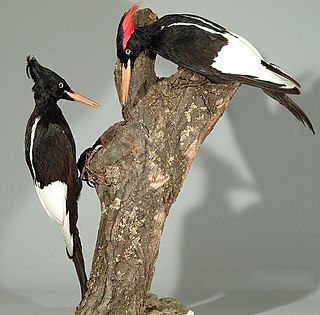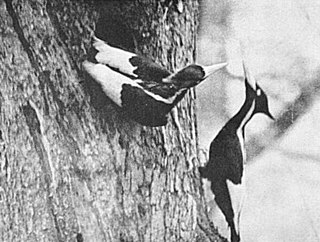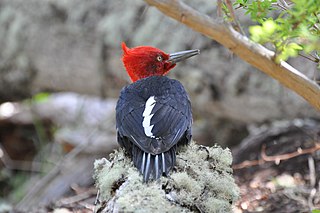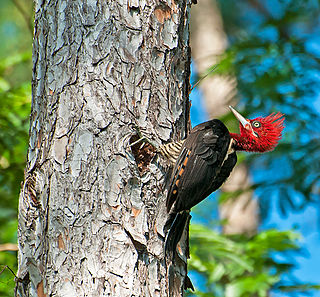 W
WCampephilus is a genus of large American woodpeckers in the family Picidae.
 W
WThe cream-backed woodpecker is a species of bird in the family Picidae. It is found in Argentina, Bolivia, Brazil, Paraguay and far northwestern Uruguay. Its natural habitat is subtropical or tropical dry forests.
 W
WThe crimson-bellied woodpecker is a species of bird in the family Picidae. It is found in Colombia, Ecuador, Panama, and Peru. Its natural habitats are subtropical or tropical moist lowland forest and subtropical or tropical moist montane forest.
 W
WThe crimson-crested Woodpecker is a very large woodpecker which is a resident breeding bird from Panama south to northern border regions of Argentina, and on Trinidad.
 W
WThe Cuban ivory-billed woodpecker or carpintero real is a Cuban subspecies of the ivory-billed woodpecker. Originally classified as a separate subspecies, recent research has indicated that C. p. bairdii may, in fact, be sufficiently distinct from the nominate subspecies to once again be regarded as a species in its own right.
 W
WThe Guayaquil woodpecker is a species of bird in the family Picidae. It is found in southern Colombia, Ecuador and northern Peru. Its natural habitats are subtropical or tropical dry forests and subtropical or tropical moist lowland forests. It is threatened by habitat loss.
 W
WThe imperial woodpecker is a species of bird, a member of the woodpecker family Picidae. The genus Campephilus is essentially a tropical one, embracing 13 species, including the imperial woodpecker. If it is not extinct, it is the world's largest woodpecker species, at 56–60 cm (22–23.5 in) long. Researchers have discovered that the imperial woodpecker has slow climbing strides and a fast wing-flap rate compared with other woodpeckers. Owing to its close taxonomic relationship, and its similarity in appearance, to the ivory-billed woodpecker, it is sometimes called the Mexican ivory-billed woodpecker, but this name is also used for the extant pale-billed woodpecker. The large and conspicuous bird has long been known to the native inhabitants of Mexico and was called cuauhtotomomi in Nahuatl, uagam by the Tepehuán, and cumecócari by the Tarahumara.
 W
WThe ivory-billed woodpecker is one of the largest woodpeckers in the world, at roughly 51 centimetres long and 76 centimetres in wingspan. It is native to the bottomland hardwood forests and temperate coniferous forests of the Southeastern United States and Cuba. Habitat destruction and, to a lesser extent, hunting has reduced populations so thoroughly that the species is listed as critically endangered by the International Union for Conservation of Nature, and the American Birding Association lists the ivory-billed woodpecker as a class 6 species, a category it defines as "definitely or probably extinct". The last universally accepted sighting of an American ivory-billed woodpecker occurred in Louisiana in 1944. However, sporadic reports of sightings and other evidence of the birds' persistence have continued ever since. In the 21st century, reported sightings and analyses of audio and visual recordings have been published in peer-reviewed scientific journals as evidence that the species persists in Arkansas, Louisiana, and Florida. Various land purchases and habitat restoration efforts have been initiated in areas where sightings and other evidence have suggested a relatively high probability the species exists, to protect any surviving individuals.
 W
WThe Magellanic woodpecker is a very large woodpecker found in southern Chile and southwestern Argentina; it is resident within its range. This species is the southernmost example of the genus Campephilus, which includes the famous ivory-billed woodpecker.
 W
WThe pale-billed woodpecker is a very large woodpecker that is a resident breeding bird from northern Mexico to western Panama.
 W
WThe powerful woodpecker is a species of bird in the family Picidae. It is found in Colombia, Ecuador, Peru, and Venezuela. This little-known species is a large woodpecker, 33–38 cm (13–15 in) long, and is a close relative to the North American ivory-billed woodpecker.
 W
WThe red-necked woodpecker is a species of bird in the family Picidae. It is found in Bolivia, Brazil, Colombia, Ecuador, French Guiana, Guyana, Peru, Suriname, and Venezuela. Its natural habitats are subtropical or tropical moist lowland forest and subtropical or tropical moist montane forest.
 W
WThe robust woodpecker is a species of bird in the family Picidae. It is found in Argentina, Brazil, and Paraguay. Its natural habitats are subtropical or tropical moist lowland forest and subtropical or tropical moist montane forest.